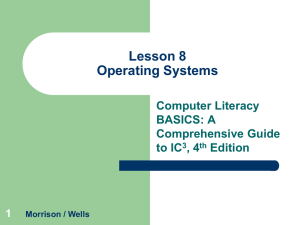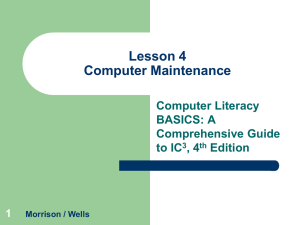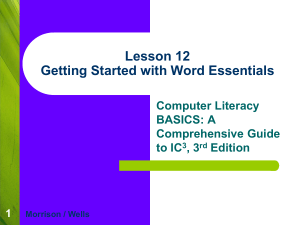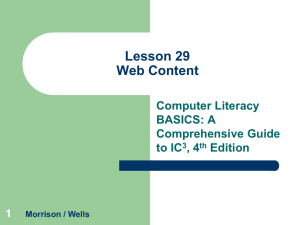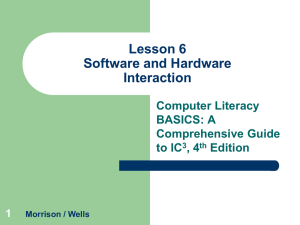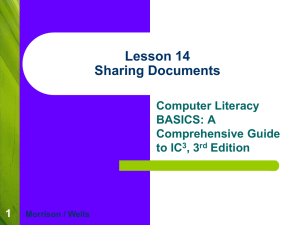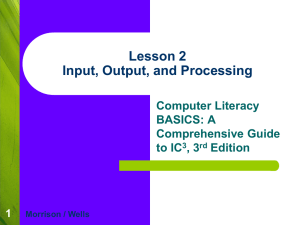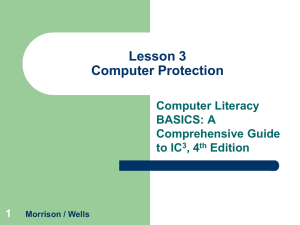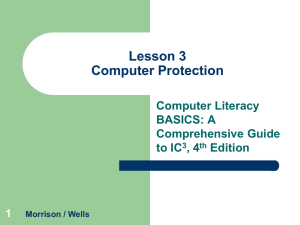Lesson 5 Computer
advertisement
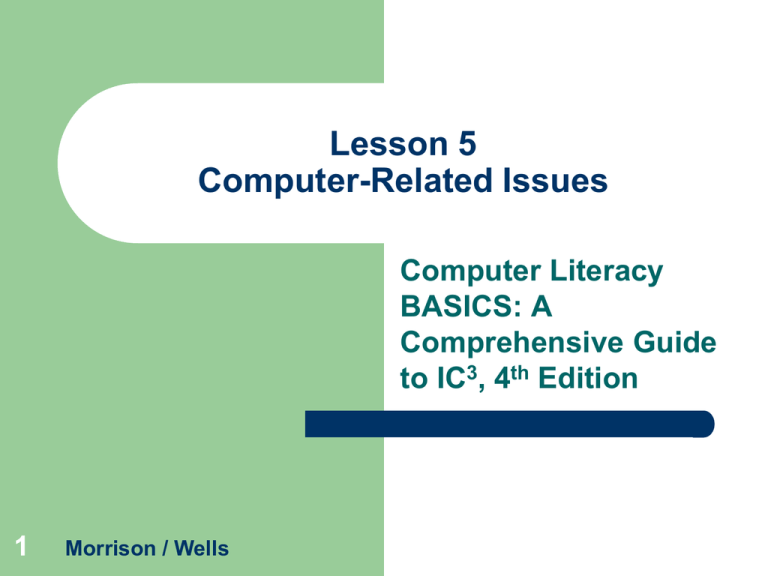
Lesson 5 Computer-Related Issues Computer Literacy BASICS: A Comprehensive Guide to IC3, 4th Edition 1 Morrison / Wells Objectives Lesson 5 2 Follow the problem-solving process. Implement solutions. Identify computer issues for consumers. Discard equipment responsibly. Morrison / Wells CLB: A Comp Guide to IC3 4E Vocabulary Lesson 5 3 Linux PC problem solving support agreement troubleshooting useful life warranty Morrison / Wells CLB: A Comp Guide to IC3 4E Following the Problem-Solving Process Lesson 5 4 The following steps outline the process you should take to solve problems: 1. Define the problem. 2. Investigate and analyze the problem. 3. Identify possible solutions. 4. Select and implement a solution. 5. Evaluate solutions. Each step is important in the problem-solving process, also called troubleshooting. Morrison / Wells CLB: A Comp Guide to IC3 4E Following the Problem-Solving Process (continued) Lesson 5 5 Define the Problem: Make sure you actually have a problem and identify what it is. Start with the most obvious or simplest possibilities, and continue troubleshooting from there. Ask questions, use what-if statements, eliminate some facts, include others, clarify the current situation, and identify what the situation should be or what you want it to be. Collect as much information as possible. Morrison / Wells CLB: A Comp Guide to IC3 4E Following the Problem-Solving Process (continued) Lesson 5 6 Investigate and Analyze the Problem: Collect all available data about the problem. Determine why the problem exists and its possible causes. Attempt to reproduce the problem, noting what actions you take to do so. The investigation and analysis step provides information you need to make an accurate decision. Morrison / Wells CLB: A Comp Guide to IC3 4E Following the Problem-Solving Process (continued) Lesson 5 7 Identify Possible Solutions: After diagnosing the problem, identify possible solutions. In exploring possible answers, you may identify more than one solution. Start with the most basic possible solutions or those that are the easiest to try. Morrison / Wells CLB: A Comp Guide to IC3 4E Following the Problem-Solving Process (continued) Lesson 5 8 Select and Implement a Solution: If you identify more than one possible solution, critique and test one solution at a time to determine its likely outcome. Choose the solution that provides the best outcome. Avoid combining solutions, because you might not know which one solved the problem. If you are not sure about the consequences of your actions, look for help and advice from an expert source. Morrison / Wells CLB: A Comp Guide to IC3 4E Following the Problem-Solving Process (continued) Lesson 5 9 Confirm the Solution: After putting the selected solution into place, you need to evaluate its performance. If your solution did not eliminate the problem, you need to try a different solution. If the solution did not work at all, return to the first step, work through your original questions, and determine if you missed a problem or symptom before testing new solutions. Morrison / Wells CLB: A Comp Guide to IC3 4E Following the Problem-Solving Process (continued) Lesson 5 10 Document the Problem and the Solution: Prepare written documentation describing the problem and the solution. Organize the notes you took during the problemsolving process so you and others can easily refer to the information again. If you discovered a way to avoid or prevent similar problems, begin to follow that practice as soon as possible. Morrison / Wells CLB: A Comp Guide to IC3 4E Following the Problem-Solving Process (continued) Lesson 5 11 Document the Problem and the Solution (continued): Keep in mind that solving problems is not a linear process. Morrison / Wells CLB: A Comp Guide to IC3 4E Implementing Solutions Lesson 5 12 The following steps illustrate how to troubleshoot the problem and find a solution. 1. Identify the problem. The printer is not working 2. Investigate and analyze the problem. Collect data. Review the manual provided for the printer. Check the Web site of the printer’s manufacturer. Morrison / Wells CLB: A Comp Guide to IC3 4E Lesson 5 Implementing Solutions (continued) 13 3. Identify possible solutions. Ask questions to identify likely solutions. Is the printer plugged in? Is it turned on? Is it beeping? Is it jammed? 4. Select and implement a solution. Test possible solutions until you find one that is likely to work, then implement the solution. 5. Confirm the solution. Turn off the computer and printer, turn them back on, and then test again. Morrison / Wells CLB: A Comp Guide to IC3 4E Implementing Solutions (continued) 6. Document the problem and the solution. Lesson 5 14 Describe the symptoms and write down the steps required to resolve the problem. Save the document and print a copy. File the copy or keep it in a notebook. Morrison / Wells CLB: A Comp Guide to IC3 4E Identifying Computer Issues for Consumers Lesson 5 15 Purchasing, maintaining, and repairing a computer requires considerable research and focused decision making. Purchasing a Computer Identify the purpose and tasks for which the computer will be used. To guide purchasing decisions, most organizations have a list of approved computer models and standard software packages. Morrison / Wells CLB: A Comp Guide to IC3 4E Identifying Computer Issues for Consumers (continued) Lesson 5 16 Purchasing a Computer (continued): Purchasing a computer for personal use most often means selecting one that runs the latest version of the Windows or Macintosh operating system. Personal computers are typically used for writing papers or letters, tracking personal finances, playing games, and connecting to the Internet. A Linux PC is a standard personal computer that runs the Linux operating system. All primary applications are available for Linux. Morrison / Wells CLB: A Comp Guide to IC3 4E Identifying Computer Issues for Consumers (continued) Lesson 5 17 Maintaining a Computer: Computers require maintenance on a regular schedule. Generally, routine maintenance can be performed by the average computer user. Post-sale service and support is critical. Most companies purchase a computer that comes with a parts-and-labor limited warranty that covers the hardware for one to three years. Morrison / Wells CLB: A Comp Guide to IC3 4E Identifying Computer Issues for Consumers (continued) Maintaining a Computer (continued): Warranties: A warranty is a written guarantee that a product or service meets certain specifications. It usually explains that if the product or service doesn’t meet the specifications, the manufacturer will repair or replace it. Lesson 5 18 Morrison / Wells CLB: A Comp Guide to IC3 4E Identifying Computer Issues for Consumers (continued) Maintaining a Computer (continued): Look for the following in a computer warranty: Determine if it includes software coverage. – Check for on-site repair and the length of time it is in force. – Check the period of free telephone support; look for a minimum of 90 days with no limitations. – Confirm that technical support is available 24 hours a day, seven days a week. – Determine if a toll-free number or Web site is provided. – Check if the warranty still applies if the computer is used outside the country. Morrison / Wells CLB: A Comp Guide to IC3 4E Lesson 5 – 19 Identifying Computer Issues for Consumers (continued) Lesson 5 20 Maintaining a Computer (continued): Support Agreements: A support agreement is a list of services specifically designed to provide assistance to an organization. This allows a company or user to budget for support just like they would for rent or insurance. A support agreement can apply to a variety of services, depending on the type of equipment. Morrison / Wells CLB: A Comp Guide to IC3 4E Identifying Computer Issues for Consumers (continued) Lesson 5 21 Useful Life: Useful life is defined as the estimated time period that an asset, such as computer equipment, will be of use to the owner. Depending of the type of company, the time period can vary from one year to five years. Depending on the value and condition of the computer, some companies may extend the life of a computer by adding components or upgrading parts. Morrison / Wells CLB: A Comp Guide to IC3 4E Discarding Equipment Responsibly Lesson 5 22 At some point, you need to dispose of or discard computer equipment. The U.S. Environmental Protection Agency (EPA) has a Web site containing basic information on the disposal of electronics (www.epa.gov/osw/conserve/materials/ecycling/basic.htm). If equipment is still usable, donate it to agencies such as schools, nonprofit organizations, and lowerincome families. Morrison / Wells CLB: A Comp Guide to IC3 4E Discarding Equipment Responsibly (continued) Lesson 5 23 If donating is not an option, consider recycling. Many cities and communities provide recycling centers. Morrison / Wells CLB: A Comp Guide to IC3 4E Lesson 5 Summary 24 In this lesson, you learned: Problem solving involves defining a problem and finding a solution. The sequence of problem-solving tasks is as follows: defining the problem, investigating and analyzing the problem, identifying possible solutions, selecting and implementing the best solution, evaluating the chosen solution, and then documenting the problem and solution. Morrison / Wells CLB: A Comp Guide to IC3 4E Summary (continued) Lesson 5 25 When purchasing a computer for yourself or for an organization, identify the purpose of the computer and the tasks you or others will perform on it. Purchasing a computer for personal use most often means selecting one that runs the latest version of the Windows or Macintosh operating system. Computers running the Linux operating system primarily are popular with knowledgeable IT professionals and home users with limited funds. Morrison / Wells CLB: A Comp Guide to IC3 4E Summary (continued) Lesson 5 26 Warranties and support agreements help you maintain computer equipment. If a computer fails to perform according to guidelines the manufacturer specifies, the warranty might provide for the repair or replacement of the computer. A computer manufacturer might offer its customers a support agreement, which is a list of services specifically designed to provide assistance to a company or organization. Morrison / Wells CLB: A Comp Guide to IC3 4E Summary (continued) Lesson 5 27 When you purchase computer equipment, be aware of its useful life, which is the estimated time period the computer equipment will be of use to you. To dispose of computer equipment properly, refer to the guidelines on the EPA Web site and consider donating or recycling the equipment. Morrison / Wells CLB: A Comp Guide to IC3 4E
